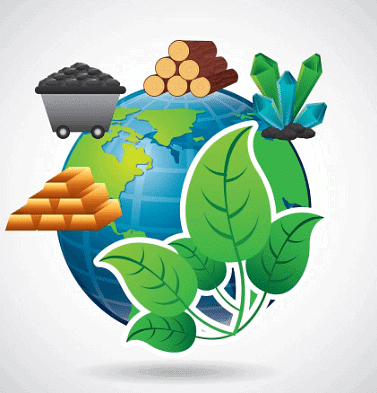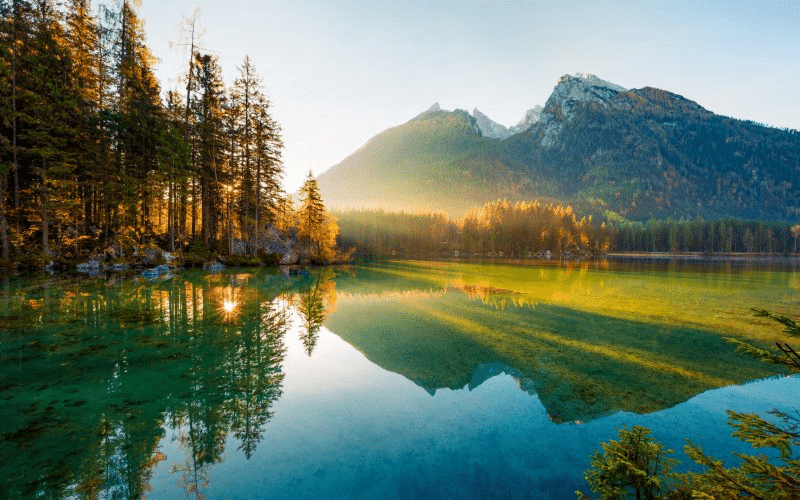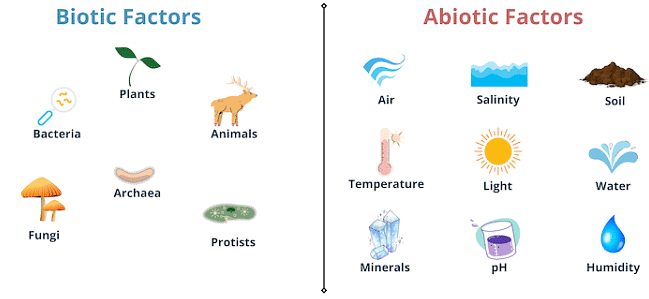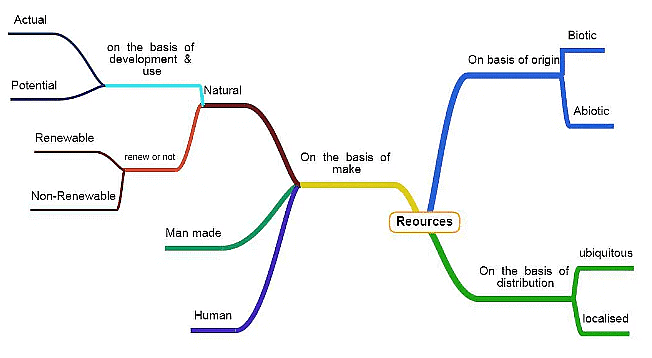Class 8 Exam > Class 8 Notes > Social Studies (SST) Class 8 > Short Notes - Resources
Class 8 Geography Chapter 1 Notes - Resources
| Table of contents |

|
| Resource |

|
| Types Of Resources |

|
| Conservation Of Resources |

|
| Flow Learning |

|
| Words that Matter |

|
Resource
Any substance, living being or service that has utility (i.e. can help us in any possible way) is said to be a resource.
- A resource has some value. Its usefulness gives it value. All resources possess value, which can be linked to money (you need to pay for it) or just mental satisfaction (for example, enjoying a beautiful painting or view).
- Examples of resources include the water you drink when thirsty, the electricity in your home, the rickshaw you take home from school, the textbooks you study from, as well as books, stationery, clothing, utensils, furniture, your teacher, school, rivers, and more.
- Some resources can gain economic value over time.
- A substance may or may not be a resource depending on our knowledge. For instance, if you don’t know how to use a pen, it has no utility for you. In that case, the pen is not a resource. However, for those who can use a pen, it is a resource. Thus, technology, ideas, knowledge, inventions, and discoveries can turn a substance into a resource.
- Time and technology are two crucial factors that can transform substances into resources. For example, water has always existed, but its utility for generating electricity was not always understood. Once people realised that water can be used to produce electricity, it became a resource in a new way.
- People are the most important resource. Their ideas, knowledge, inventions, and discoveries lead to the creation of more resources.
 Resources
Resources
Types Of Resources
Resources may be natural, human, or human-made.
Natural Resources
- Natural resources are those that are taken from nature. They are used without modifying them, i.e. in the same form as they exist in. Rivers, lakes, air, soils, minerals, trees, mountains, etc. are natural resources.
 Natural Resources
Natural Resources - On the basis of level of development of resource, a natural resource can be actual or potential.
- An actual resource is one which is used currently. We know their quantity. Examples are: coal deposits.
- A potential resource is one whose utility is not known at present or is not used despite having utility; instead it may be useful at some time in future. It means that it has the potential to have utility, although it does not have any today. Examples include uranium deposits in Ladakh.
- On the basis of origin, a resource can be abiotic or biotic.
- A biotic resource is one that has life. Examples: plants and animals.
- An abiotic resource is non-living. Examples: light, air, furniture, books.
 Biotic and Abiotic Resources
Biotic and Abiotic Resources
- Natural resources can be divided into renewable and non-renewable resources.
- A renewable resource can be used without fear of it running out, although careless use can deplete its stock. They are available in unlimited quantities, such as solar energy and wind energy. Conversely, non-renewable resources must be managed carefully because once they are depleted, they cannot be replaced. Examples include coal and petroleum.
 Renewable and Non-renewable Resources
Renewable and Non-renewable Resources
- Based on distribution, resources can be ubiquitous or localized. A ubiquitous resource is found everywhere, like air.
- A localized resource is only found in specific locations, such as coal, which is not available universally.
The distribution of natural resources is influenced by various physical factors, including terrain, climate, and altitude.
Human-made Resources
- Human-made resources are created from natural resources.
- People have used their intelligence to make these resources for wider societal use. Examples are buildings, bridges, roads, machinery, and vehicles.
- Sometimes, natural materials become resources only after their original form is altered.
- Technology is also a human-made resource.
Human Resources
- Human resources include people who assist us in various roles, such as your teacher, doctor, carpenter, and cobbler.
- Human resource development means improving people's skills so they become more useful and serve as a better resource.
- People are the most important resource.
Conservation Of Resources
- Resource conservation means using resources wisely so they last longer. This involves allowing time for resources to renew. Future generations also require these resources, and if we continue using them at a rapid rate, they might run out, which could create issues for the future. Our planet's future and the well-being of its inhabitants depend on our ability to sustain and protect the natural life support systems.
- It is essential to find a balance between using resources and preserving them for future use. This balance is known as sustainable development.
- There are numerous ways to conserve resources. Everyone can help by reducing consumption, recycling, and reusing items.

Flow Learning

Words that Matter
- Utility- A substance has utility if it can be used in any possible way to satisfy our needs.
- Value- Worth of a substance assessed on the basis of utility.
- Patent- It applies to the exclusive right over any idea or invention.
- Resource- Any substance having utility in any way is a resource.
- Technology- The application of the latest knowledge and skills in doing or making things is called technology.
- Natural Resource- Natural resources are those that are taken from nature.
- Actual Resource- An actual resource is one which is used currently and whose quantity is known.
- Potential Resource- A potential resource is one whose utility is not known at present or is not used despite having utility; instead it may be useful at some time in future.
- Abiotic Resource- An abiotic resource is a non-living resource
- Biotic Resource- A biotic resource is a living resource.
- Renewable Resource- A renewable resource can be used without any risk of its ending up because they exist in unlimited quantity.
- Non-renewable Resource- A non-renewable resource is one which is present in limited quantity.
- Ubiquitous Resource- A ubiquitous resource is one that is found everywhere.
- Localised Resource- A resource that is found only in certain parts of the world and not everywhere.
- Human-made Resource- Resources invented by human beings by using their intelligence are called human made resources.
- Human Resources- A human being who can contribute to his family, society, or economy is called a human resource.
- Human Resource Development- Human resource development refers to the improvement of people’s skills so that they become more useful than before and are a better resource.
- Stock of Resource- The amount of resource available for use is called its stock.
- Resource Conservation- Resource conservation is the concept of using resources carefully so that they do not end up quickly.
- Sustainable Development- It is the concept of using resources in a balanced way so that our purpose is solved, as well as they are also conserved for the future.
The document Class 8 Geography Chapter 1 Notes - Resources is a part of the Class 8 Course Social Studies (SST) Class 8.
All you need of Class 8 at this link: Class 8
|
69 videos|431 docs|46 tests
|
FAQs on Class 8 Geography Chapter 1 Notes - Resources
| 1. What are the different types of resources? |  |
Ans. There are four types of resources: natural resources, human resources, capital resources, and entrepreneurship resources. Natural resources include air, water, soil, minerals, plants, and animals. Human resources refer to the people who contribute their skills and labor. Capital resources are man-made tools and equipment used in production, such as machinery and buildings. Entrepreneurship resources involve the skills and creativity of individuals who start and manage businesses.
| 2. What is conservation of resources? |  |
Ans. Conservation of resources refers to the responsible use and management of natural resources to ensure their sustainability for future generations. It involves reducing waste, practicing recycling, using renewable energy sources, and adopting sustainable practices. Conservation efforts aim to protect and preserve the environment, prevent resource depletion, and promote a more sustainable way of living.
| 3. What is flow learning? |  |
Ans. Flow learning is an educational approach that emphasizes experiential and hands-on learning. It involves immersing students in real-life experiences and actively engaging them in the learning process. Flow learning encourages students to explore, experiment, and discover knowledge through direct experiences. It aims to promote deep understanding, critical thinking, and a lifelong love for learning.
| 4. What are words that matter in the context of resources? |  |
Ans. In the context of resources, "words that matter" refer to key concepts, terms, or ideas that are essential for understanding and discussing the topic. These words help to convey important information, facilitate effective communication, and enable individuals to grasp the significance of resources. Examples of words that matter in the context of resources include conservation, sustainability, renewable, depletion, and management.
| 5. How can we conserve resources in our daily lives? |  |
Ans. There are several ways to conserve resources in our daily lives. We can reduce energy consumption by turning off lights and appliances when not in use, using energy-efficient lighting and appliances, and insulating our homes. Conserving water can be achieved by fixing leaks, taking shorter showers, and using water-saving devices. Recycling and composting can help reduce waste and conserve natural resources. Finally, practicing mindful consumption, such as buying only what is necessary and opting for sustainable products, can also contribute to resource conservation.
Related Searches





















